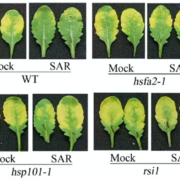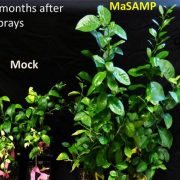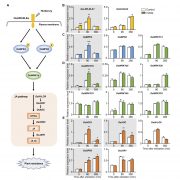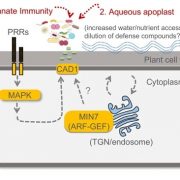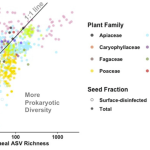A mitochondrial RNA processing protein mediates plant immunity to a broad spectrum of pathogens by modulating the mitochondrial oxidative burst (Plant Cell)
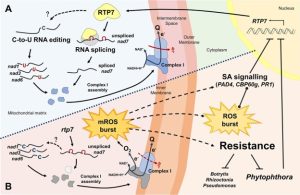 Phytophthora are a group of oomycete pathogens that infect a wide range of plants and cause disease in many important crop species. Large scale mutant screens have previously been used to identify Arabidopsis thaliana mutants with enhanced resistance to P. parasitica. Here, Yang and colleagues investigate the mechanisms underlying resistance in one such mutant, rtp7. The researchers show that RTP7, a nuclear encoded protein, localizes to mitochondria. There it participates in RNA splicing of nad7 transcripts, a mitochondrial gene encoding one of the subunits of mitochondrial respiratory chain Complex I. The group examined mitochondrial function in rtp7 plants and found decreased Complex I activity as well as increased expression of the alternative oxidase family genes, suggesting elevated production of mitochondrial reactive oxygen species (ROS). The researchers then used chemical ROS scavengers as well as plants deficient in the plasma membrane NADPH oxidases RBOHD and RBOHF to show that the increased resistance in rtp7 plants is due to mitochondrial ROS, and may be independent of the plasma membrane localized ROS bursts. Finally, the group used phylogenetic techniques to show that RTP7 is highly conserved and confirmed that silencing of rtp7 in Nicotiana benthamiana and Solanum lycopersicum also results in enhanced resistance to P. infestans. (Summary by Rory Burke @Rorby95) Plant Cell 10.1093/plcell/koac082
Phytophthora are a group of oomycete pathogens that infect a wide range of plants and cause disease in many important crop species. Large scale mutant screens have previously been used to identify Arabidopsis thaliana mutants with enhanced resistance to P. parasitica. Here, Yang and colleagues investigate the mechanisms underlying resistance in one such mutant, rtp7. The researchers show that RTP7, a nuclear encoded protein, localizes to mitochondria. There it participates in RNA splicing of nad7 transcripts, a mitochondrial gene encoding one of the subunits of mitochondrial respiratory chain Complex I. The group examined mitochondrial function in rtp7 plants and found decreased Complex I activity as well as increased expression of the alternative oxidase family genes, suggesting elevated production of mitochondrial reactive oxygen species (ROS). The researchers then used chemical ROS scavengers as well as plants deficient in the plasma membrane NADPH oxidases RBOHD and RBOHF to show that the increased resistance in rtp7 plants is due to mitochondrial ROS, and may be independent of the plasma membrane localized ROS bursts. Finally, the group used phylogenetic techniques to show that RTP7 is highly conserved and confirmed that silencing of rtp7 in Nicotiana benthamiana and Solanum lycopersicum also results in enhanced resistance to P. infestans. (Summary by Rory Burke @Rorby95) Plant Cell 10.1093/plcell/koac082


